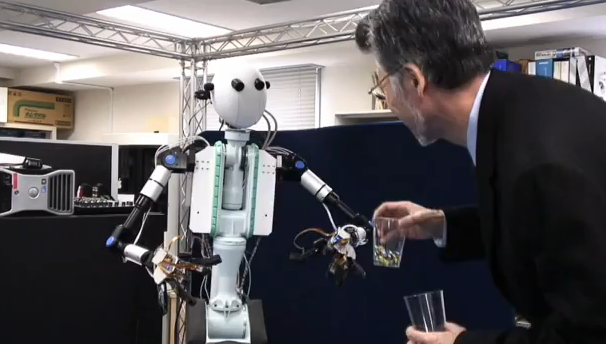A robot said to be the beginning of the real life world as seen in James Cameron blockbuster Avatar is being developed by scientists and Keio University’s Graduates School of Media and Design in Minato, Tokyo. A series of attachable gadgets, including headset and gloves allow a human user to control the ‘droid – called TELESAR V (or TELexistence Surrogate Anthropomorphic Robot), to pick up and move objects or perform other tasks with a view to aiding in disaster areas and places no human can step foot such as the devastated Fukushima nuclear plant which was hit during the earthquake and tsunamis in March 2011.
Slipping on a pair of motion sensor gloves and a video headset the wearer’s every movement is mimicked by the robot (which somewhat reminds us of the endearing Johnny 5 from Short Circuit) and the TELESAR V’s eyes are actually cameras which relay video back to the headset wearer so just like the alien cloned Avatars in the movie, the machine can be used to do whatever a human being commands – from a first person perspective. In addition the wearer can talk and the voice will be played through speakers in the ‘bot’s bonce, making the machine a fully functioning representation of that person.
One researcher on the project, Sho Kamuro says “When I put on the devices and move my body, I see my hands having turned into the robot hands. When I move my head, I get a different view from the one I had before”. Demonstrating the sensitive sensor tech and it’s relation with the mecha, Sho stands some distance away from his artificial counterpart and facing away he uses the robot to pour dice from one glass to another in the robot’s hands, using the human movement translated into the machine in motion.
It’s a somewhat frightening first step towards the sci-fi fantasy world seen on screen, but the whole thing poses a question which Cameron’s movie also posed – What if you become too involved in the artificial and forget you’re really a human being?? Sho says “It’s a strange experience that makes you wonder if you’ve really become a robot”.
As well as promising improvements to access in extreme conditions and being used as a benefit for human safety during times of disaster the main man behind the TELESAR V, Professor Sasumi Tachi believes the ‘droid can bring a more personal touch to long-distance relationships and communication. He says “This could be used to talk with your grandpa or grandma living in a remote place and deepen communications”.
Let us know your thoughts on our comments below or via our @Gadget_Helpline Twitter page or Official Facebook group.
Source: ASF


